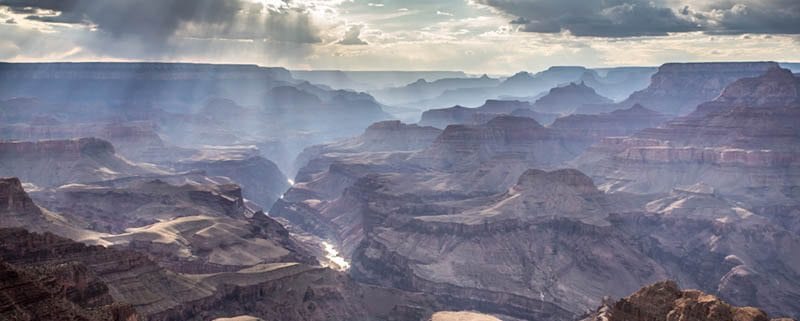Grand Canyon Experts | A conversation with Ivo Lucchitta Part 2
Q. What are the key clues for you, where the geology first gets interesting … and then other parts of the story?
A. It is when we get to the oldest sedimentary rocks, those between 850 and 1200 million years old. We see the presence of oxygen and an abundance of primitive life. By the time we get to the base of the Paleozoic – 550 million years ago – there was an explosion of life, mostly single-celled plants. There were organisms of great diversity, mostly marine – life really originated in the sea. All the fundamental problems of life were really solved in the early Paleozoic time. For example – the evolution of complex multi-celled organisms sensing the environment, supporting the body, moving around. Many of those kinds of major things were solved in early Paleozoic time – that’s not shabby.
There really wasn’t much of anything on land, no plants or animals – the land looked like Mars. Then at the end of Paleozoic time that’s when you start seeing plants and amphibians. So, at Grand Canyon when we get to the Coconino sandstone there are leaf imprints and tracks of amphibians and reptilians. The geologic time frame called the Mississippian and Pennsylvanian are combined into one and called the Carbiniferous in Europe. Plants exploded [into being] on land. There were big trees – they didn’t look like our present-day trees but were more like ferns and palms, that kind of stuff. So fundamentally the Paleozoic was the realm of sea animals – the sea was where the action was for most of that time. And then we get to the end of the Paleozoic, represented by the Kaibab limestone on the rim of Grand Canyon – there the Canyon story, the geologic story, ends. Above the Kaibab limestone is the Moenkopi formation and at the boundary between the two some 98 percent of species disappeared.
Q. This is a fascinating sketch of Grand Canyon geology. Can you tell us more?
A. Yes, well the Moenkopi rocks were everywhere – it used to be across the Grand Canyon before the Grand Canyon existed. And that great extinction opens up a new era – the Mesozoic – or middle life. This was the era of great reptilians including the dinosaurs. But, the dinosaurs were only one branch. The reptiles of all shapes and sizes were the dominant life form then.
Then, about 60 million years ago there was another big extinction. This was at the end of the Mesozoic. It was clearly the result of an asteroid impact – the science about that is unassailable in my view. So now we open another scene in the play – the Cenozoic, the recent or young life. That was the age of mammals – there was other life, of course, but mammals are the dominant form. And then at the very end – in the last 2 million years – came homo sapiens – a very arrogant critter. Really it has been though only in the last 50,000 years or so when homo sapiens came on the scene in a major kind of way.
Q. Although it is a complicated story how would you describe something about the Colorado River and how it carved the Canyon?
A For me, the geologist, the history of the Grand Canyon is a detective story. Here it is a difficult story too because rivers eat their children. We have to do the best we can. The only way we really make progress in science is showing what could not be. You narrow the field of possibilities. Another issue with the detective story: how do we estimate how the Colorado River came to its present course in Grand Canyon? There are no end of arguments about that.
My research shows that Grand Canyon is no more than 5 million years old. I have spent years in figuring out things about the Colorado River in Grand Canyon and its present course. In 1964 I participated in a symposium at the Museum of Northern Arizona, a group of scientists came together and it was led by Edwin McKee, the father of Grand Canyon geology. [link: http://library.nau.edu/speccoll/guide/m/mckee.html]
Right about that time I had done my Ph.D. thesis on the mouth of the Grand Canyon. My research leads me to the conclusion that a more ancient drainage existed on the Plateau. It was a drainage that did not go where the western river in Grand Canyon does today. At upper lake Mead, the area near Pierce Ferry, there are 5 million year old deposits that indicate interior drainage, not a through-flowing river like the Colorado – at the mouth of Grand Canyon. It is a spectacular place, the northern edge of Grapevine Mesa. There is an old World War II-era airport there, and it’s still used as a landing strip for private aircraft. That is the place to see what I’m talking about, you look straight down from there and see the 5 million year old deposits.
Q. So you’ve brought us up to this era, what next?
A. The last section, the last era is that of the River and humans. The Colorado River and Grand Canyon have been incredible teachers for us. You have the pre-historic Puebloans. At the place on the Colorado River through Grand Canyon between the confluence of the Little Colorado River and the Unkar delta – it is wide open there and the sandstone is soft, it erodes easily. You can’t take three steps without seeing a pot shard or some kind of evidence of these people. They were farming and farming intensely – these were the ancestors of the Hopi and others. They were farming corn for sure – I have done pollen studies and it is clearly corn here at the Unkar region because we found corn pollen and corn pollen does not travel.
In that part of the Canyon there are also eroded cut banks that show multiple layers of charcoal, one above the other. I have studied the carbon layer and sampled intensively for pollen. From the charcoal you can get radio carbon dating and the results show the youngest or uppermost layer to be about from 1200 B.C. The next to the bottom layer, the second oldest contains pollen and is dated at about 3500 years ago. This makes it an old-world chronology, around the time of Ramses II and Moses in Egypt – way back in time. And the oldest layer is perhaps 3500 years before the present. Those prehistoric Puebloan people in Grand Canyon were doing farming that long ago, and probably considerably earlier. It leads you to the suspicion that agriculture developed in a lot of places.
Q. So why were these people farming there?
A. All of the silts around there are on a river terrace that is about 33 feet or 10 meters above the current Colorado River grade. So far as one can tell that was the floodplain where they were farming – 30 feet higher than the River is now. The River was over laden with sediment – overburdened rivers build up – stuff gets dropped out. It was a braided stream – that’s what it looked like. The River at that time overtopped its banks and spread way out. And this brought in a new layer of fertile soil. There are a lot of pre-Puebloan sites on top of that – three meters higher – and they kept getting buried.
Q. So when did farming stop in Grand Canyon?
A We have found Pueblo II sites on top of the terrace. That tells you that somewhere between 1200 and 1300 years ago the River stopped building up its bed. Somewhere at that time the Colorado River started cutting down to its present level. The River wasn’t overloaded with sediment anymore – that’s when it started cutting down.
Many of the archaeological sites are covered by dunes – that is the typical thing you see – the windblown sand. That’s what I think – it goes against the conventional wisdom – but the reason the people really left Grand Canyon was not because of drought – it was they couldn’t farm anymore because the river level dropped so they could not irrigate any more, the water table dropped with it so the sand of the terrace dried out, and started blowing, forming dunes over the fields.
This in no way precludes the possible arrival of hostile people. I have found many roasting pits – these are likely Paiute, Ute, etc. They are not Puebloan. So the combination of difficult farming because of the sand and the arrival of unfriendlies – it’s a combination of things.
Q Where does that bring us in this Grand Canyon detective story?
A The whole thing of the River and present-day humans and dams. So far as I can tell there was an awareness of the silting up of reservoirs, like at Lake Powell and Lake Mead when they were built. But what happens downstream of Glen Canyon Dam? There has been erosion, archaeological sites are being endangered, the environment has been changing drastically since the dam. In a very serious kind of way the River has been a teacher. It has taught us what we know and what we know about what happens when we build dams.
Ivo Lucchitta was born in 1937 in the former Czechoslovakia. He received a baccalaureate in classics in Rome. He emigrated to the U.S. in 1965, attended CalTech and earned a B.S. in 1961. He attended Penn State and earned a Ph.D. in 1966. In his early career he worked for the USGS in Flagstaff in the Apollo program working on lunar exploration. Also with USGS he later did fieldwork, geological fieldwork in Alaska, Wyoming, Idaho and Arizona. Ivo Lucchitta is an author of many scientific articles and of Hiking Arizona’s Geology, the Mountaineers Books, 2001. He retired in 1995 but has remained active in an Emeritus capacity with USGS, as an adjunct professor at Northern Arizona University and as a research associate at the Museum of Northern Arizona. He is currently working on a book about Grand Canyon for Oxford University Press.
Resources and for further reading:
www.lucchitta.com/ivo/index.shtml.com
Hiking Arizona’s Geology, by Ivo Lucchitta, The Mountaineers Books, 2011.




